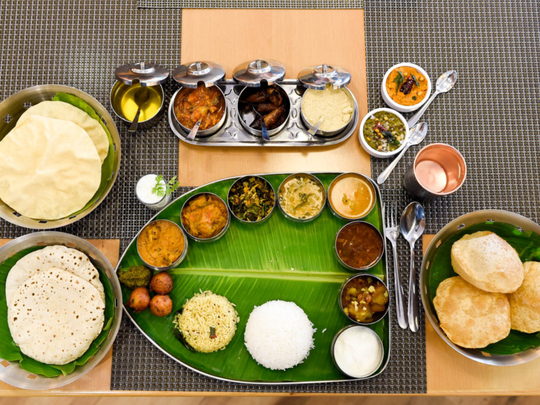
Dubai: Indians like to explore food from different regions of the country. And every state offers its own variety of thalis (lunch/dinner platter). You may have tried thalis from Kerala, Gujarat, Rajasthan and Punjab to name a few that are available in Dubai. You may also find the North Indian thali and South Indian thali in some restaurants, which is an incoherent mix of several dishes, with no distinctive profile.
But the Andhra thali is undoubtedly the ‘king of all thalis’. And what makes it qualify for this distinction is its sheer range and fiery characteristics.
Be warned! You’ve got to be made of sterner stuff to approach the Andhra thali. But if you survive the modati mudda (the first bite), there’s no stopping you.
Oh, the unmissable gongura pachadi
A typical Andhra meal comprises pappu (lentils), vepudu (fried dry vegetable preparations such as potato, okra, bitter gourd, plantain, ivy gourd), gravy-based curries, pulusu (a tangy broth made with tamarind juice or sour yoghurt with vegetables) and yoghurt. Not to omit the spicy powders, pickles, chutneys and of course the desserts. Traditional thali sweet offerings are the boorelu (sweet dumplings made of rice flour, jaggery and soft-cooked lentils) or bobbatlu, a flat bread stuffed with the same mix, all served on a glistening banana leaf.
Of course, it is possible you will find the thali being served on a plate with small bowls holding the many items. But what you probably won’t find in a typical Andhra thali are the chapatis, rotis or puris. People from Andhra, a state also known as the ‘rice bowl of India’ relish their rice at all meals.
The one item that everyone craves in an Andhra thali is the gongura pachadi (chutney). Gongura or the leaves of the Roselle plant (Hibiscus sabdariffa) are a staple item in Andhra cuisine and are used in a variety of ways, the most popular of which is the gongura pickle. A fiery preparation of gongura leaves, red chillies, whole spices and oil, its distinctive taste is best enjoyed with hot rice and a generous spoonful of ghee.
Then there are the podis or spice powders of Andhra which are unique. Made from a variety of dals and spiked with red chillies and other spices, these ‘gunpowders’ as they are also called, are usually eaten with rice. The other stars in the list of accompaniments are the legendary Andhra pickles, the most famous of which is the avakaya or raw mango pickle.
So, let’s look at the order of progression while relishing an Andhra thali.
First, you mix a little of the spice powder with some hot rice, pour in some ghee, roll it into a small ball and pop it into your mouth. The explosion of the spice tempered by the muted solace offered by the rice and ghee is unforgettable, both for experienced diners and novices. The former relive the joy for the nth time and the latter are introduced to what can turn into a potential craving. Done with the podi, you can have a similar tryst with the gongura pickle or the avakaya.
Astonishing range
Next, you move on to pappu (dals) that include plain and spiced versions and which can also include a range of vegetables such as cabbage, tomato and the many varieties from the gourd family.
The curries are next in line. A range of vegetables are transformed into delicacies through creative use of spices and cooking methods. The Andhra guttivankaya koora (stuffed brinjal curry), a marvel of a dish using plump baby brinjals in a tangy, spicy sauce of onions, tomatoes, groundnut and sesame is an all-time favourite.
Nearly every vegetable enjoys a delicious transformation, including the much-feared bitter gourd. My all-time favourite is goruchikkudu (cluster beans).
Leafy vegetable preparations can vary depending on their seasonal availability and are succulently incorporated into dals, curries, and broths.
The tempered, spiced or mild broths of Andhra are another unique feature of its cuisine. The pulusu and the rasam are typical liquid preparations that use vegetables and tempering in an astonishing range of flavours to be eaten with rice
You round off the meal with majjiga (laban) or curds, with a touch of a pickle of your choice to give the creamy yoghurt a lick of fire. Did I miss mentioning the papad? This fried or roasted tortilla-like black gram flour crispy can be crunched at any time during the meal.
Having eaten like a king, it’s time for the last, unmissable ritual — desserts. Boorelu or bobbatlu? Every morsel is a sweet sensation.
Clearly, it’s best to go for an Andhra thali at a time when you are feeling ravenously hungry.
Where to find Andhra thalis in Dubai
Very few restaurants serve Andhra meals in Dubai. Amaravathi and Prabha’s in Karama and Sri Krishna Bhavan Restaurant and Ruchi in Shaikh Hamdan Colony in Bur Dubai, are among them.
While Andhra thali is synonymous with vegetarian food, Amaravathi and Ruchi cater for non-vegetarians as well with their natu kodi kura (country chicken curry), maamsam (mutton curry), chepala kura, chepala pulusu (fish curries) and chepala fry.
Sri Krishna Bhavan, located diagonally opposite Ruchi, is the latest entrant offering Andhra meals.
Vasanth Kumar, manager at Sri Krishna Bhavan, says the recently opened restaurant is an extended wing of their popular restaurant in Bengaluru started by Chandrasekhar Reddy. It’s a purely South Indian eatery that covers Andhra and Udipi cuisine.
“We have special thali called Andhra Bhojanam (Andhra feast), an unlimited platter served for lunch for just Dh18. It’s a complete meal where you get the traditional pickles and chutneys. We also serve starters such as punugulu, garelu and the hot mirapakaya bajji,” Kumar says.
The main course here comprises guthi vankaya kura, kothmir vanakaya, munakkaya (drumstick or moringa), kanda (yam) fry, and poriyals, dal and sambar.
Dal preparations with spinach (Palakura pappu), gongura, sambar and a variety of rasam are prepared at Sri Krishna.
Flavoured rice dishes are made in rotational menu, and desserts including bobbatlu, boorelu and chakkara pongali (a sweet dish of rice and jaggery) that are made on special occasions or festivals in Telugu homes are incorporated in our menu, says Kumar.
Syed Abrar, who has been in Dubai for four years, says he likes gongura pappu and gunpowder. However, he says he doesn’t find the food in Dubai as spicy as it is India. “But I am impressed with the unlimited servings portions here and the generosity of the restaurant staff. The quality is also quite good. I never thought I’d be served food on a banana leaf,” Abrar adds.
Doctor couple Vani and Gupta from Australia, who visited the restaurant with their friend Balaji, said they look forward to tasting gongura whenever they visit an Andhra restaurant. “It’s like a home away from home and I really envy Dubai residents who enjoy Andhra food here. I wish we could get Andhra food in Australia,” Dr Gupta says.
Vijay Chawla, a self-confessed foodie, says Andhra food is right up there in the top of the charts in terms of spiciness. “Andhra food has a lot of diversity. It’s a perfect choice for someone who likes spicy food. Their podis, pickles, gongura, curries, dals and rasam are a treat,” he says.
What do Andhraites say? Sony Kiran, Vanditha and Radhika, all friends living in the vicinity in Bur Dubai, say they regularly eat out at the restaurants serving Andhra meals and find the food here quite spicy and tasty.












